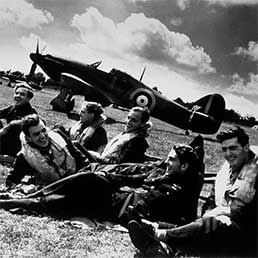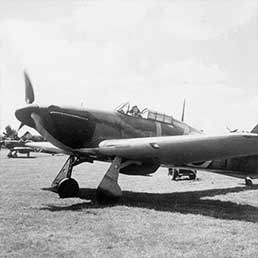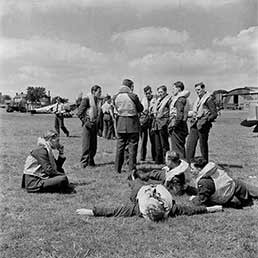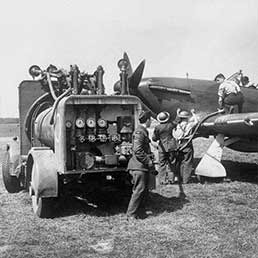Former RAF Station, Hawkinge
In 1980 the Museum acquired part of one of the last sites of Britain's epic struggle for survival in 1940, in what was to be the greatest air battle in history. RAF Hawkinge was the nearest Royal Air Force station to enemy-occupied France, with the Luftwaffe fighters, based in the Pas-de-Calais, being a mere 6 minutes flying time away. Naturally it and the surrounding district was also the target of the Luftwaffe's bombers and, in addition, was subjected to long-range cross-channel shelling from the German shore batteries stationed along the French coast. Not for nothing was the Dover and Folkestone area known as "Hellfire Corner". Despite the passing years, today's visitor can still savour the atmosphere of the airfield's past with the landmarks, and the buildings that remain, acting as reminders of those perilous days. Indeed, prior to the development of the airfield in 1993, one could still see the English Channel and the French coast from this historic spot. This is the story of RAF Hawkinge:
When the Battle of Britain began, on 10th July 1940, RAF Hawkinge had already been in existence for twenty years. Earlier a tiny field, originally owned by Lord Radnor, had been used by William Bernard Megone, who for many years was believed to be a Dutch aviation pioneer, but in reality, was a former English Barrister turned ‘aeroplane manufacturer’ who, although refusing to pilot his own contraptions, had induced a friend, Victor Hunt, to make various flying attempts. The majority were quite unsuccessful although on one or two occasions the flying machine, called 'Mayfly', did actually hop into the air reluctantly. The first recorded flight from Hawkinge was in January 1910.
Megone left just before the Royal Flying Corps arrived in 1915 to establish a primitive airfield from which they were to ferry various aircraft to and fro across the English Channel. It was a bit hit-and-miss affair and quite a number of pilots lost their way, especially when a sea mist closed in around them. Aerial navigation was by rule of thumb and if pilots had a compass they considered themselves very lucky.
Engine failure was commonplace for all manner of reasons. There was one occasion when a luckless pilot found he had flown over German held lines. He eventually ran out of fuel and was taken prisoner.
The First World War had been raging for three years before the aerodrome buildings took on a more permanent outlook. The first buildings to go up were the huge Belfast Trussed hangars. Previously the small airfield had been known as Folkestone, but it was now the 'Aerodrome Despatch Section Hawkinge.' The sound of whirring propellers and spluttering engines brought a new and quite unique fascination to the Hawkinge villagers. Through its strategic location the rebuilt aerodrome became a vital link in the British Defence system and, after the Armistice had been signed, it became the base for the famous No.25 (F) Squadron flying Sopwith Snipes.
In the peaceful years between the two world wars squadron aircraft of the Royal Air Force became most colourful, especially the fighter aircraft, which were daubed with all sorts of insignia. In addition, the flying expertise of the squadron pilots became proudly symbolic of all peace-time training. Hawkinge is specially remembered for the spectacle of magnificent synchronised formation flying when squadron aircraft were tied together with bunting. Aerobatics, either by a formation of aircraft or by a single aircraft, were an everyday occurrence. High-powered aero-engines shattered the tranquillity of meadow and country lane long before the Luftwaffe arrived to do combat. During those colourful years of peacetime flying No.25 Squadron changed their aircraft as new designs were introduced.
When the Sopwith Snipe fighter became obsolete, the Gloster Grebe replaced it. This was a nice single-seater fighter but had an alarming wing-flutter which caused a few problems for the pilots. Then along came the ponderous Armstrong Whitworth Siskin, the all-weather fighter with a new-fangled heated cockpit which brought about the untimely death of at least one pilot.
The Sidney Camm designed Hawker Fury came next and, because of its feline streamlined fuselage, was a winner from the start. It was known officially as an "Interceptor" and was later updated and called the Super Fury.
Then in 1938 the incomparable Fury gave way to the Hawker Demon two-seater fighter. Received from another squadron, instead of being new stock, the Demons were already due for replacement. The new Gloster Gladiator came on the scene for a few months before being replaced by the two engine Bristol Blenheim IF ?fighter-bomber. The grass airfield was unsuitable for such an aircraft and the squadron was ordered to move to Northolt near London.
No.25 (F) Squadron had been at RAF Hawkinge for nineteen years and for part of that time had shared facilities with No.2 Army Co-Operation Squadron. When this squadron arrived from Manston in 1934 they were flying the Hawker Audax bi-plane but these were changed to the Hawker Hector.
Flying with the Royal Air Force had been a great adventure for young men seeking excitement. Now there was to be a change as Hitler's armies drew closer to the French coast. Quite suddenly aerodrome defence became all important. Thousands of sandbags were acquired and filled. Machine-gun posts, dugouts and shelters suddenly sprang up around the airfield perimeter. Every building was camouflaged with drab green and brown paint. It was in complete contrast to the white-wash which had prevailed during the thirties. The flowering rose gardens and shrubs looked out of place.
Machine-guns and the mobile 40mm Bofors anti-aircraft guns soon arrived to take up their positions. Windows and doors were protected by piles of sandbags. By June 1940 the aerodrome was more or less ready for Hitler's war. It was fully operational when the Dunkirk evacuation was taking place. The few Army Co-Operation squadrons still remaining in the country were soon organised to fly from Hawkinge to drop supplies of ammunition, food and water to beleaguered troops at Calais and Boulogne on the French coast.
Under the control of Fighter Command, Hawkinge had become a satellite airfield of Biggin Hill Sector Station. It was already in the 'front-line' when Luftwaffe activity increased in the skies over Kent.
Our defending eight-gun fighter squadrons of Hurricanes and Spitfires flew down to Hawkinge at first light every day to operate their sorties from dawn till dusk when they would fall back inland to relative safety. Soon aerial battles were being fought at anything from 2,000 to 20,000 feet. There were many exploits of individual gallantry – some of them have never been documented.
Their stories died with them when they succumbed to the 'crack' German fighter and bomber units. The Battle of Britain was, without doubt, the last period in English history where one was likely to witness close aerial combat between two elite Air Forces.
Luftwaffe pilots were courageous and tenacious opponents. Our own British, Commonwealth and Allied pilots were reckoned to be men of superior qualities backed up by good training, equipment and leadership. Such a combination, laced with their own brand of courage and aggression, surely gave them a buoyant invincibility when they knew they were terribly outnumbered. Statistics have proved that, without doubt, time and again our defending squadrons were being stretched beyond limits of endurance.
The first Hurricane and Spitfire squadrons to arrive at Hawkinge during the summer of 1940 usually touched down at about 5.00 am when ground crews were just crawling out of bed. The pilots ate their breakfast beside their aeroplanes, where parachutes rested on their tail planes ready for any emergency. They waited for the Tannoy to give the 'Scramble.' At least twenty-six fighter squadrons used Hawkinge during the summer of 1940 and included No's 32, 64, 72, 79, 111, 141, 245, 501, 610 and 615.
It became an everyday occurrence to see fighters crash-landing on the aerodrome. The pilots wrestled with combat damaged aircraft which had been blasted by cannon-fire and raked with machine-gun bullets. Wings, ailerons, fuselages and rudders were often torn to shreds. Overheating engines, belching oily smoke, often precluded any sort of visibility when landing. Undercarriage failed to lock down on landing because of lost hydraulics. Many crashes were quite catastrophic. Fire Tender and Ambulance crews had never experienced such utter confusion. Wounded pilots and aircrew were lifted tenderly from their soiled cockpits. One or two had died as they landed. The little mortuary, only twelve feet square, had never been designed to accommodate so many mortally wounded airmen.
Eye-witness accounts abound of aerial combat and crashes. One witness recalls a Spitfire, '…..hovering over the edge of the airfield like a Sparrow hawk before flying through a wire fence. The barbed wire wound round the propeller like cotton on a bobbin. The Spitfire tipped up on its nose and did a complete somersault.' Another witness recalls seeing the C.O. of No.79 Squadron, Squadron Leader Joslin, being shot down just after taking off from Hawkinge.'
'I saw the Hurricanes climbing up from the airfield and way behind the rest was one solitary Hurricane trying to catch up. But he never made it. As I watched there was a big flash, then the fighter fell out of the sky in bits and pieces. The C.O. never stood a chance.'
With so much activity going on the anti-aircraft gun crews had become 'trigger happy.' They began to open fire at any aeroplane which came within their particular area. Consequently, a number of our own pilots were shot down with tragic results. Talking of tragedies, the one which concerns No.141 Squadron must surely be the most poignant. They had been scrambled from the airfield about lunchtime on 19th July and had just reached the middle of the English Channel when they were bounced by the famous Richthofen Geschwader. Four Defiants were lost, shot down in the first pass. Two more would fall to the guns of the Messerschmitt Bf 109E's. Of the Squadron, ten pilots and aircrew were killed or posted as 'missing'.
Surviving pilots, now sadly most of whom have passed, whether of the Battle of Britain period or any other, will have had mixed feelings about flying from Hawkinge. Some remembered it with affection; other remembered it with horror because of their own individual and particular combat experiences.
On 12th August 1940 Hawkinge was to receive the first of countless attacks on the airfield and what follows is the report from the station's Operations Record Book. On this occasion the airfield was attacked by Erprobungsgruppe 210, a Luftwaffe precision fighter bomber unit, flying Messerschmitt Bf 110s and Bf 109s (not the Junkers Ju 88s quoted in the Operations Record Book).
"Bombing attack by Ju88s against the Station was carried out at 17.30 hrs. and lasted approximately 10 minutes. One hangar, No.3, was almost completely wrecked whilst another, No.5, was partially wrecked. A number of bombs of heavy calibre, including incendiary, were dropped. The aerodrome and buildings were machine gunned during the attack. The main stores were partly damaged by fire, the clothing store almost completely.
The fire was quickly brought under control by RAF personnel aided by the local AFS (Auxiliary Fire Service). Station Workshops were wrecked. Two houses in the Airmen's Married Quarters occupied by airmen were destroyed. Twenty-eight craters were made on the aerodrome, the longest being 76' x 72' x 28' deep (23mtrs x 22mtrs x 8.5mtrs) and the smallest 10' x 10' x 8' deep (3.04mtrs x 3.04mtrs x 2.4mtrs), but the aerodrome was not rendered completely unserviceable. Repairs to the surface were immediately commenced by the REs (Royal Engineers) already attached for such work.
Ground defences were surprised and no guns, except two Hispano, were fired. The altitude of the attacking aircraft was such that is was impractical for the PACU to be brought into action. (Parachute & Cable Unit- a device which fired a rocket up to about 2,000 feet, at which height a large & small parachute deployed, the larger one carrying the rocket and the smaller carrying a 1,000 foot cable at the end of which was a mine. The idea was for the aircraft's wing to catch the cable and drag it across the wing until the mine made contact and blew the wing off). Two civilians employed by the Contractors of Works and three airmen were killed. Six airmen received severe injuries and were admitted to the Kent and Canterbury Hospital, Canterbury. The casualties occurred to the personnel employed in No.3 Hangar. Two Spitfire aircraft, under repair, were damaged, whilst one or two others were struck by splinters. Two non-operational aircraft on charge were damaged but repairable."
The attacking aircraft suffered no losses. The attack left seven men dead within feet of where the Museum stands today. No.3 Hangar received several direct hits and the towering iron Belfast Hangar doors came off their top runners and crushed to death an airman and two civilian employees, Mr Brisley and Mr McCaister. Within the body of the hangar Corporal McColl and three more airmen were killed. The site of this death and destruction, for many years after the war, was the Hawkinge Parish Council's football pitch and is now been redeveloped into housing.
Within three days Hawkinge was receiving its second major attack of the war, this time by the dreaded Junkers Ju 87B 'Stukas'. The gull-winged dive-bombers were peeling off and screaming down upon running airmen amidst the deafening crash of gun fire. Sizzling hot shrapnel cut into trees and buildings as smoke spiralled aloft in a huge grey blanket of cloud. Seven 'Stukas' were shot down, two of them by one of our own pilots, Flt/Lt. John A. A. Gibson, but his Hurricane was hit by return fire, forcing him to bail out.
And so, the battles raged on. Every day brought new traumatic experiences to test Fighter Command and its personnel. Our pilots were fighting gallantly while the hard pressed groundcrew were nursing ailing aeroplanes until midnight and sometimes beyond. Everyone worked as a team, men and machines, flesh and steel.
By the time Hitler's Luftwaffe had turned from bombing the aerodromes to bombing London and other towns and cities, Hawkinge had its own fighter reconnaissance squadron in residence. This was originally known as No.421 Flight, later becoming No.91 (Nigerian) Squadron, better known as the 'Jim Crow' Squadron. The pilots were a mixture of nationalities. There were French, Belgian, American and Canadian amongst their ranks. They became famous for their particular methods of attacking just about every sort of enemy target, including shipping and Luftwaffe airfields close to the English Channel.
Towards the end of 1941 No.277 (Air Sea Rescue) Squadron, flying Lysander, Defiant and the amphibious Walrus, took up their base at Hawkinge. They scoured the English Channel from one end to the other picking up 'ditched' airmen, both German and English, and later on American bomber crews. Because of the daring 'Jim Crow' attacks the Germans retaliated with sporadic fighter-bomber raids on Hawkinge. The Messerschmitt Bf 109s usually arrived over the airfield at midday, dropping their single high explosive bomb amongst the station buildings and shooting up the dispersed Spitfires. They usually operated either singly or in pairs. Flying at sea level they were undetected by our radar units which resulted in the surprise attacks. Airmen were often caught out in the open before they could dive for cover.
From 1942, through to 1943, the aerodrome became a 'Jump-off' airfield for numerous intruder missions, for it was now the RAF's turn to blast the German airfields, fuel dumps, harbour installations, railways, roads and all lines of communications.
In the autumn of 1943 the 'Jim Crow' squadron left. They had achieved many distinctions, not least the formidable array of pilot decorations. They had gained many 'kills' and lost some very good pilots. The unit was regarded as outstanding. Squadron personalities included the Frenchman 'Moses' Demozay, Jean Maridor and De Moline, the South African 'Chris' Le Roux, the New Zealanders Spurdle and Pannel, and the Americans 'Art' Donahue and Young.
By 1944, the airfield had been host to many fighter squadrons of different nationalities such as Czech, Dutch, Belgian, Canadian and Australian. They all flew on bomber escorts, reconnaissance and intruder missions and, by July that year, they were knocking the dreaded 'Doodlebugs' out of the skies over Kent. It is interesting to record that of all the aircraft to fly from RAF Hawkinge during the Second World War the Spitfire,that graceful fighter which has become a legend in the Royal Air Force history, remained dominant throughout.
When the Jet age was upon us with the development of the Gloster Meteor, this old grass airfield became obsolete almost overnight.
And so, after hostilities with Germany ceased, the aerodrome changed from a thriving Fighter Station to a home for the WAAF Technical Training Depot. In December 1955, the Home Gliding Centre was set up at the aerodrome to train ATC cadets who arrived for one week courses under the expert guidance of RAF pilots and civilian instructors. The Women's Royal Air Force, as they later became known, were still using the buildings when the aerodrome finally closed on 8th December 1961. By 1964 the Ministry of Defence could find no further use for RAF Hawkinge and it was offered for sale by auction on 9th July.
Seven years later, in June 1968, Harry Saltzman arrived with his entourage to transform the old aerodrome back into its former wartime glory, to produce scenes for the classic motion film 'Battle of Britain.'
Now if you ever visit the Museum and stand within its grounds on the site of the former airfield, you will almost certainly sense its history. It doesn't require much imagination to conjure up a picture in your mind of the Hurricanes and Spitfires and their pilots who were revered and respected for their individual gallantry. If you listen hard enough, you can hear the crackle of a Merlin exhaust and the voices of the airmen still haunting this former airfield. Hawkinge achieved immortal fame and earned the gratitude of a nation at war and this is why it was critical that we created the Museum's home here, amongst some of its original wartime buildings.
(Based on the book" Airfields of the Battle of Britain – Hawkinge" by Roy Humphreys)
If you would like any more information about the Kent Battle of Britain Museum and its team of volunteers please e-mail us, thanks.




